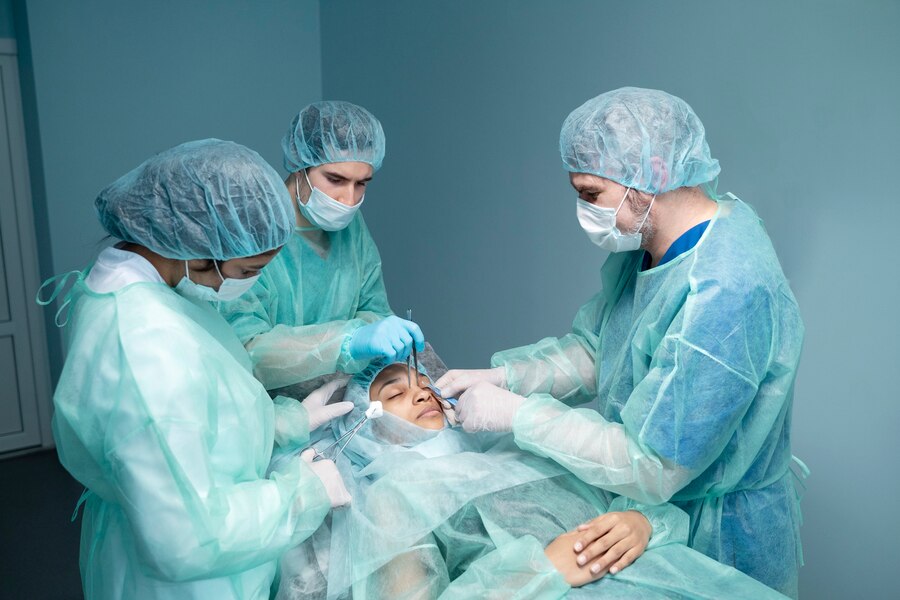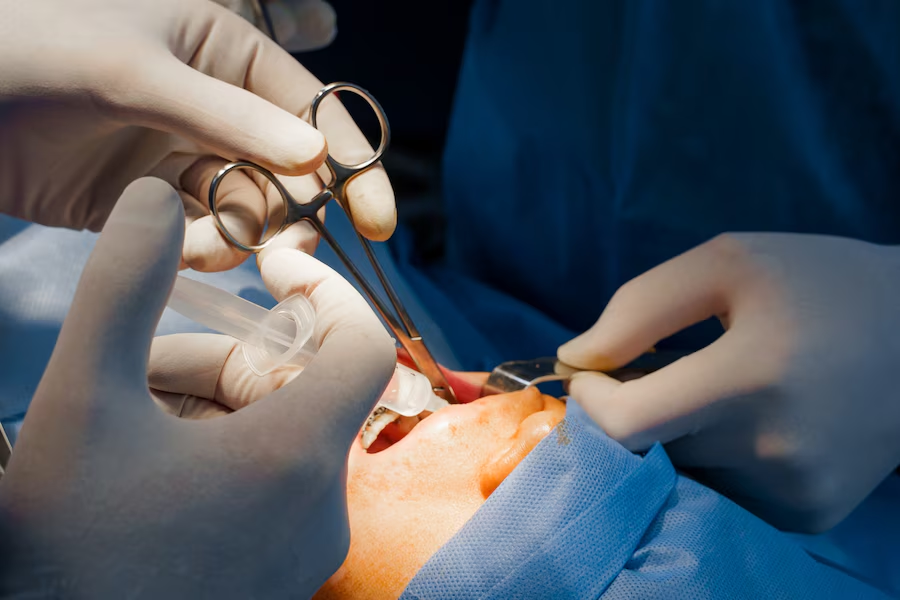

Advanced ENT surgeries encompass a range of innovative procedures designed to address complex conditions of the ear, nose, and throat with precision and minimal invasiveness. These surgeries often utilize state-of-the-art technology and techniques to enhance outcomes and reduce recovery times. Some examples include:
Sinusitis is a common condition that feels much like a head cold, with a blocked, stuffy, or runny nose that often gets better with medication except in rare cases. This is caused by the inflammation and swelling of the inner lining of the sinuses (air spaces around the nose). This swelling leads to the blockage of the sinuses obstructing the mucous from draining out, thus creating pain in the face with the pressure of the blocked fluid.
Endoscopic sinus surgery is becoming the procedure of choice for most doctors as against traditional types of surgeries to correct blockages in the nose and sinuses. It can correct chronic or severe blockages in one or more of the maxillary, ethmoid, frontal, or sphenoid sinuses.
Hearing loss is one of the most common disorders of the ear and can affect anyone in their lifetime. Various reasons are responsible for causing hearing loss and the treatment is based on which type of hearing loss the patient is suffering from.
Rhinoplasty, referred to as a "nose job" or "nose reshaping" by patients, is a surgery done to enhance the facial harmony and the proportion of your nose with the face. It also corrects the impaired breathing, caused by structural defects in the nose.
Rhinoplasty is indicated for medical reasons like correcting breathing problems or deformity of nose resulting from trauma or birth defects. Also, it is performed for cosmetic reasons to improve the shape of the nose, nasal asymmetry etc. for better appeal.
The ear is described as having three parts - the outer ear, middle ear and the inner ear. Tympanoplasty is the surgery performed to repair the perforated ear drum (tympanic membrane) or the small bones of the middle ear (ossicles). "Perforated ear drum" or "tympanic membrane eardrum" is a hole in the tissue that separates the ear canal from ear drum (middle ear). This may result from the chronic infection or trauma of the eardrum.
Sound waves, or vibrations, are produced, travel through the external auditory canal, and strike the eardrum (tympanic membrane) when they do. The eardrum vibrates. Sound waves are amplified by the ossicles and directed towards the inner ear, where they enter the cochlea, a fluid-filled hearing organ.
Balloon Sinuplasty is a type of endoscopic surgery to open the blocked sinus passage ways and relieve many sinuses. It is performed to treat patients with sinusitis seeking relief from uncomfortable sinus pain. This is a safe and effective sinus procedure for chronic sinusitis. This surgery can be performed in a hospital or in the office of an ear, nose, and throat (ENT) physician.
The surgery is performed under local or general anaesthesia. This procedure involves the insertion of a small sinus balloon into the blocked natural outflow tracts of the sinuses using a tiny telescope. Placement of the balloon within the sinus cavity is checked by illuminating an LED light attached to the balloon and sometimes using a 3D computer assistance program to confirm accurate placement.
Mastoidectomy is a surgical procedure of the temporal bone that opens postauricular air cells by removing the thin bony dividing sections between them. Each mastoidectomy is unique because of the variable pneumatization patterns of the temporal bone. Additionally, pathology may restrict the mastoid cells' ability to pneumatize and complicate the mastoidectomy procedure.
It is essential to carry out a mastoid exploration to remove all diseased parts of the bone to remove or reduce the risk of complications like, loss of hearing, affecting sense of balance, facial paralysis and brain infections.
Immediate treatment is required if symptoms include laryngeal trauma, fracture, or dislocation and acute airway obstruction for vocal cord dysfunction, airway hematoma/bleeding, or edema, otherwise it can be life-threatening.
If a person suffers from hoarseness for more than two weeks then there might be a chance of larynx cancer and immediate treatment must be done.
This procedure locates the underlying cause of the voice problem. If it is possible, the surgeon adds a procedure to improve the quality of the voice.
Surgical removal of tonsils is called tonsillectomy. Tonsils are located in the back of the throat and are a part of our immune system that defends the body from infections. Tonsillectomy is usually performed on children.
A tonsillectomy is performed under general anaesthesia and takes about 20–30 minutes. In the most common method, the surgeon removes tonsils using a scalpel. Other tonsillectomy methods include using coblation, radio frequency ablation, or CO2 laser to remove tonsils.
A tonsillectomy has no adverse effect on the body’s immunity.
Snoring and sleep apnea are caused because of airflow obstruction. The surgeon will first examine and investigate to identify the sites of airflow obstruction. Then as per the diagnosis, he may decide to undertake single or multiple procedures in one stage or in multiple stages to minimize these obstructions and bring relief from snoring and sleep apnea.
Surgical treatments for obstructive sleep apnoea include:
Tumors and foreign objects can be found during rigid esophagoscopy, among other problems. It is useful for modest surgical operations, such enlarging a narrowed area, in addition to diagnostics.
A rigid esophagoscopy involves inserting a tube with a lens and light down the esophagus to help diagnose various conditions. Moreover, it can assist medical professionals in carrying out surgical procedures like removing foreign objects.
© Samhitha ENT & Children's Hospital. All Rights Reserved.
Designed by The Patterns Company